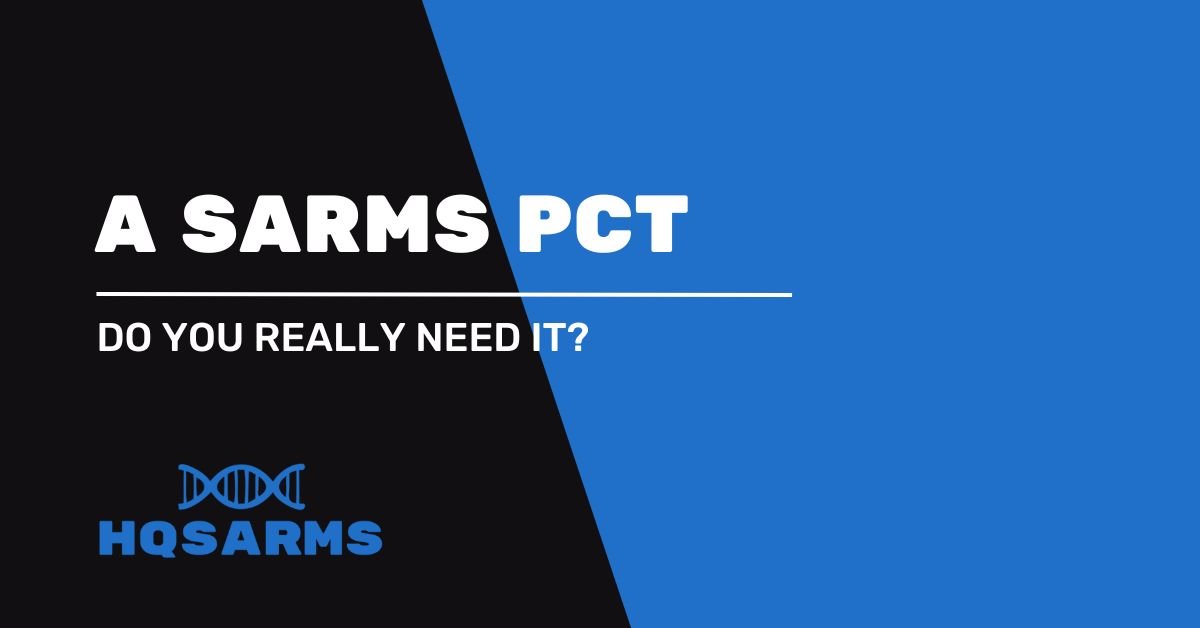Table of Contents
SARMs are a possibly safer alternative to Androgenic Anabolic Steroids (AAS). In general, SARMs have fewer side effects than steroids and do not cause the same amount of suppression. Therefore, people wonder if they need a PCT (Post Cycle Therapy) after using SARMs.
In this article, we intend to get to the bottom of this question. We will discuss if and why a PCT is important after a SARM cycle, what the most popular PCT for SARMs is.
What is a PCT?
When you use testosterone or any other androgenic anabolic steroid, your body gets a signal that there is enough testosterone available. As a result, the natural production of testosterone will decrease.
When you finish your cycle, hormone levels will be low. In order to prevent losing your hard-earned muscle mass, a PCT (Post Cycle Therapy) is highly recommended after a cycle of androgenic anabolic steroids (AAS).
Do SARMs require a PCT?
But do SARMs require a PCT? The answer is not a straightforward “yes” or “no.” It depends on which SARM, at which dosage an for how long you have been using.
Although SARMs do not cause the same amount of suppression that androgenic steroids do, they will still have an impact on natural testosterone levels. Symptoms of low hormone levels include reduced libido, fatigue, insomnia, decreased muscle mass, and emotional changes.
The purpose of a SARM PCT is to reduce the side effects associated with post-cycle hormonal imbalance and help to restore natural testosterone levels.

Which SARMs require a PCT?
MK-2866 (Ostarine)
Ostarine (MK-2866) is by far one of the most popular SARMs around. It is also the mildest one, giving the least amount of suppression. Any dip in natural testosterone levels will quickly return back to baseline after the use is discontinued.
As such, there is no need for a PCT for MK 2866, unless it has been used at extremely high dosages during a prolonged period of time.
LGD-4033 (Ligandrol)
Ligandrol (LGD-4033) is one of the most potent SARMs currently available. It has a powerful effect on increasing muscle mass and strength. The amount of suppression associated with the use of LGD-4033 is highly dose dependend. When used at a low dose for a short duration, the decrease in natural testosterone production will be limited and bounce back quickly after the end of a cycle.
At higher dosages or for a longer duration, it is absolutely recommended to use some form of Post Cycle Therapy such as Enclomiphene. The same is also true when used in a stack with other SARMs.
RAD-140 (Testolone)
Testolone (RAD-140) is considered the strongest non-steroidal SARM on the market. It is highly effective in building muscle mass as well as strength.
RAD 140 is also one of the more suppressive SARMs around, which means that a PCT for RAD 140 is advised when taking high dosages or a long cycle.
YK-11
YK-11 is an unusual SARM in a number of ways. Not only because it is a myostatin inhibitor, but also because it is the only steroidal SARM currently on the market. Chemically, it looks like a DHT derivative, which according to some makes it an anabolic steroid. There is some debate on how suppressive it is, but the overall consensus is that you do need a PCT after a cycle of YK-11.
S-23
S-23 is by far the most suppressive SARM on the market, and it is actually being evaluated as a potential male hormonal contraceptive. As a result, S23 is very suppressive, equivalent to steroid suppression in terms of Testosterone suppression. This means that a PCT is absolutely needed after a cycle of S-23.
S-4 (Andarine)
Andarine, aka S-4, is generally considered to be one of the least suppressive SARMs on the market, along with Ostarine. Still, it will decrease natural testosterone production to some extend. When used in high dosages, for an extended period, or in combination with other SARMs, a PCT is recommended.
Which SARMs do not require a PCT?
There are a number of substances that are often categorized as SARMs, but actually aren’t SARMs at all because they don’t bind to the androgen receptors. This means that they don’t suppress natural testosterone levels and, as a result, don’t require a PCT.
Cardarine (GW-501516)
Cardarine, also known as GW-501516 is not a SARM but a PPAR delta agonist. It doesn’t target the androgen receptors and has no influence on hormone levels. Cardarine therefore does not require any sort of PCT.
Stenabolic (SR-9009)
SR-9009, also known as Stenabolic, is another compound that is actually not a SARM, but an agonist of Rev-ErbA. Stenabolic is not a hormone modulator, but a metabolic modulator, modulating or inducing metabolic effects. Thus, post cycle therapy is not required with the use of Stenabolic.
Ibutamoren (MK-677)
MK 677 is another compound that is actually not a SARM, but a growth hormone secretagogue, mimicking the growth hormone-stimulating action of the endogenous hormone ghrelin. Because it doesn’t target the androgen receptors, it has no influence on natural testosterone production. This means that MK-677 does not require any form of post cycle therapy.
Which type of PCT for SARMs?
Enclomiphene
Enclomiphene is an isomer of Clomiphene Citrate (also known as Clomid), a medication traditionally used to treat infertility in women. However, Enclomiphene is used differently and has been studied for its potential to stimulate the production of natural testosterone levels in men.
Enclomiphene, which is a non-steroidal estrogen receptor antagonist, has gained a lot of attention in the research community for its potential use in post-cycle therapy (PCT).
A typical Enclomiphene research cycle for PCT might last from 4 to 6 weeks. Here’s a general guide:
- Dosage: A common dosage for Enclomiphene is between 6.25-25mg per day. The specific dosage may depend on the individual’s body weight, the nature of the cycle that was completed, and the individual’s response to treatment.
- Frequency: Enclomiphene is commonly taken once per day, due to its relative short half-life.
Nolvadex
Nolvadex is a popular trade name for Tamoxifen Citrate, a SERM (Selective Estrogen Receptor Modulator) which is used for the treatment of breast cancer in women.
It binds to the estrogen receptors in our body, leaving no room for your natural estrogen to reach abnormal levels.
Clomid
Clomid is the brand name for Clomiphene (Clomifene), which is a popular SERM used to treat infertility in women. This SERM is stronger than Nolvadex and has more side effects.


